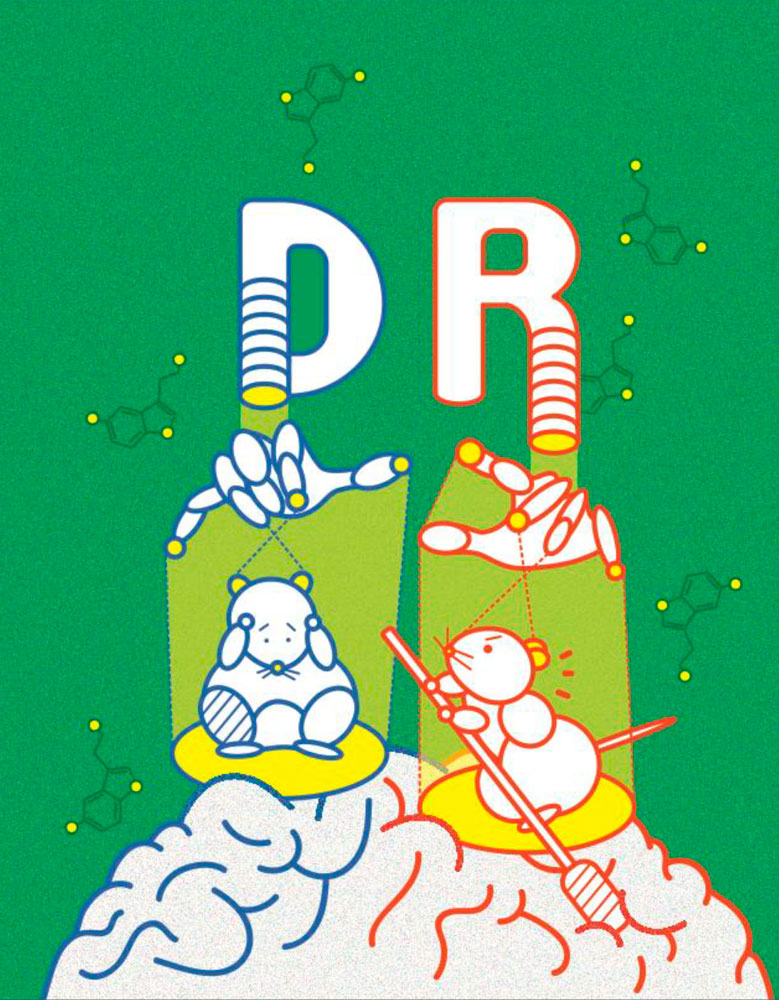

“It is possible that the serotonin in our brains play an essential part in keeping us sane”
Sir John Gaddum, 1954
The serotonin (5HT) system is believed to be the most expansive neural system, innervating nearly every area of the brain and has been implicated in the modulation of seemingly every human behavior. It is the most frequently targeted neural system pharmacologically for treating psychiatric disorders, including depression and anxiety.

Strikingly, despite its imposing breadth of influence, the serotonin system originates from a very small proportion of neurons, which constitute only 1/1000000 of all CNS neurons. The key questions that intrigue us are, how is the serotonin system organized to manage such a broad range of modulation? How is the organization of the serotonin system determined during development, and how do disruptions in these developmental programs alter this organization, and thereby possibly contribute to the pathology?

We recently revealed that there are anatomically defined parallel serotonin sub-systems that exert different influences on distinct behavioural functions of mice. We are trying to determine how individual serotonin sub-system reaches their particular target brain regions during development in mice. We shall identify the molecules that guide the neural circuit formation. After that, we shall combine multiple advanced tools to understand when some of the serotonin sub-systems fail to connect with their downstream brain regions: which aspects of the mental states are disrupted. This work will advance our understanding of the relationship between neurodevelopment and psychiatric disorders, with the potential of discovering novel targets for therapeutic interventions.
Selected Papers
- Zhongyu Li, Zengyi Shang, Jingyi Liu, Haotian Zhen, Entao Zhu, Shilin Zhong, Robyn N. Sturgess, Yitian Zhou, Xuemeng Hu, Xingyue Zhao, Yi Wu, Peiqi, Li, Rui Lin, Jing Ren (2023)
D-LMBmap: a fully automated deep-learning pipeline for whole-brain profiling of neural circuitry.
Nature Methods 1-12: - Jing Ren*#, Alina Isakova#, Drew Friedmann#, Jiawei Zeng#, Sophie Grutzner, Albert Pun, Grace Q. Zhao, Sai Saroja Kolluru, Ruiyu Wang, Rui Lin, Pengcheng Li, Anan Li, Jennifer L. Raymond, Qingming Luo, Minmin Luo, Stephen R. Quake, Liqun Luo*. (2019)
Single-cell transcriptomes and whole-brain projections of serotonin neurons in the mouse dorsal and median raphe nuclei.
eLife 8: e49424 DOI: 10.7554/eLife.49424. # These authors contributed equally. * Corresponding authors. - Ren J., Friedmann D., Xiong J., Liu CD., Ferguson BR., Weerakkody T., DeLoach KE., Ran C., Pun A., Sun Y., Weissbourd B., Neve RL., Huguenard J., Horowitz MA., Luo L. (2018)
Anatomically defined and functionally distinct dorsal raphe serotonin sub-systems.
Cell 175(2): 472-487. E20. - Ren J., Qin C., Hu F., Tan J., Qiu L., Zhao S., Feng G., Luo M. (2011)
Habenula "cholinergic" neurons corelease glutamate and acetylcholine and activate postsynaptic neurons via distinct transmission modes.
Neuron 69: 445-452.
Group Members
- Chui Kuen (Zora) Chan
- Jingwen Liang
- Cheng Qi
- Kenneth Wu